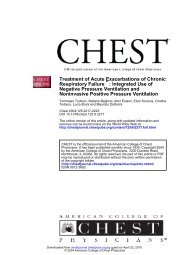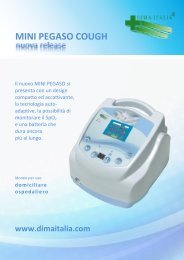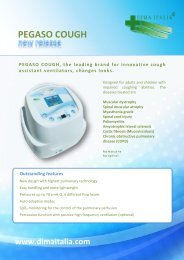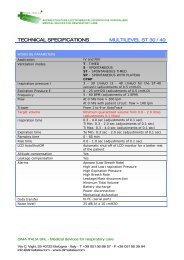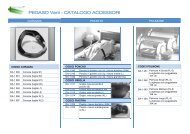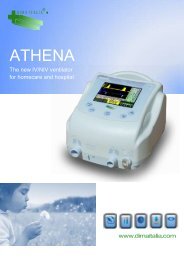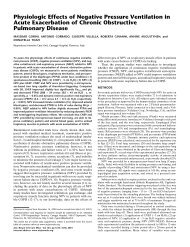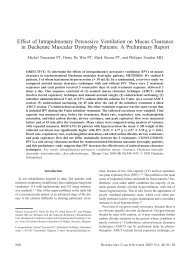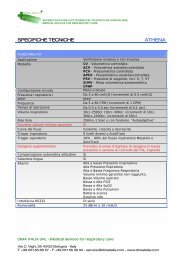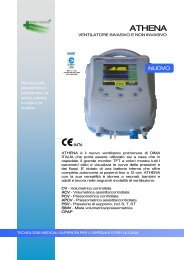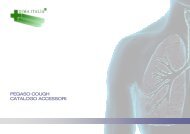Mechanical aids for secretion clearance - DIMA Italia Srl
Mechanical aids for secretion clearance - DIMA Italia Srl
Mechanical aids for secretion clearance - DIMA Italia Srl
Create successful ePaper yourself
Turn your PDF publications into a flip-book with our unique Google optimized e-Paper software.
REVIEW<br />
<strong>Mechanical</strong> <strong>aids</strong> <strong>for</strong> <strong>secretion</strong> <strong>clearance</strong><br />
M Chatwin PhD,<br />
Academic and Clinical<br />
Department of Sleep and<br />
Breathing,<br />
Royal Brompton Hospital,<br />
London, UK<br />
One in 3500 of the population may be expected to have a<br />
disabling inherited neuromuscular disease (NMD) presenting<br />
in childhood or in later life. Respiratory tract infections are a<br />
major cause of morbidity and mortality in this patient group.<br />
An effective cough is essential <strong>for</strong> <strong>secretion</strong> <strong>clearance</strong> and<br />
protection against respiratory infections. This review<br />
concentrates on mechanical <strong>aids</strong> and cough augmentation<br />
techniques to assist <strong>secretion</strong> <strong>clearance</strong> in NMD patients.<br />
Cough augmentation techniques have been shown to be safe<br />
and effective <strong>for</strong> increasing peak cough flow (PCF) in stable<br />
NMD patients and it is recommended they should be taught to<br />
all with an unassisted PCF 360 L·min -1. 5,6 In adult<br />
patients who have difficulty clearing <strong>secretion</strong>s due to respiratory<br />
muscle weakness a minimum assisted PCF of 160<br />
L·min -1 is required to clear airway debris. 1,7,8 A PCF of #270<br />
L·min -1 has been identified as a threshold <strong>for</strong> patients to be<br />
taught assisted cough techniques 1 as these patients are likely<br />
to deteriorate to the critical threshold of 160 L·min -1. Poponick<br />
and co-workers 9 demonstrated that acute viral illness was<br />
associated with a reduction in vital capacity (VC) due to a<br />
reduction in inspiratory and expiratory respiratory muscle<br />
strength (by 10–15% of baseline values), which in turn caus-<br />
es a decline in PCF to the critical level of 160 L·min -1.<br />
PCF is a simple manoeuvre to per<strong>for</strong>m; it involves the<br />
patient being encouraged to take a deep breath in and then<br />
cough into a peak flow meter via a full face mask or mouthpiece.<br />
Sancho et al. 10 reported that stable amyotrophic lateral<br />
sclerosis (ALS) patients with a PCF of >245 L·min -1were<br />
able to clear <strong>secretion</strong>s effectively with a manual assisted<br />
cough (MAC) and those with a PCF of
tive cough. Garstang et al. 19 found 89% of patients with SCI<br />
preferred MI-E to suctioning; 89% also found MI-E faster,<br />
78% found MI-E more convenient, and 72% found MI-E<br />
more effective than suctioning. Chatwin and Simonds 20 also<br />
found that the addition of MI-E to conventional airway <strong>clearance</strong><br />
shortened treatment times in NIV dependent patients.<br />
Bach and co-workers have advocated high pressure spans<br />
(+40 cmH2O to -60 cmH2O), 8,21–25while others report a good<br />
outcome with lower pressures (+30 cmH2O to -30 cmH2O 12<br />
and +20 cmH2O to -30 cmH2O 5,26).<br />
The effect of the Emerson CoughAssist device on airway<br />
pressure rather than PCF was evaluated in a physiological<br />
study involving a paediatric population. 27 The authors measured<br />
airflow and pressure via a face mask during six cycles<br />
of a 2 second insufflation followed by a 3 second exsufflation,<br />
and concluded that the pressure measured at the mask<br />
was significantly lower than the pressure indicated on the<br />
CoughAssist device. This importantly highlights the inaccuracy<br />
between the pressure settings on the device and those<br />
measured at the mouth and therapists should be less anxious<br />
about the device’s high pressure setting.<br />
<strong>Mechanical</strong> insufflator/exsufflators are expensive devices<br />
and other cough augmentation techniques (singularly or in<br />
combination) may suffice instead. MAC may be used when<br />
expiratory muscle weakness prevents effective cough. The<br />
aim of the MAC is to increase expiratory airflow by either<br />
compression of the chest wall or abdomen (see Figure 2).<br />
Synchronous compression of the abdomen when the patient<br />
coughs causes a sudden increase in abdominal pressure; this<br />
causes the abdominal contents to push the diaphragm<br />
upwards, increasing expiratory airflow. 21,28 MAC is a simple<br />
effective technique that can be used anywhere and some<br />
patients are able to use their arms to per<strong>for</strong>m their own MAC.<br />
MAC has been shown to significantly improve PCF in various<br />
groups of neuromuscular patients. 21,29,30 In stable state<br />
NMD patients with a PCF of >245 L·min -1 a MAC is likely<br />
to be adequate to clear <strong>secretion</strong>s when they are unwell. 10<br />
If inspiratory muscle weakness is a problem then the patient<br />
will benefit from various techniques. The aim is to produce a<br />
MIC; this is the maximum volume of air stacked within the<br />
patient’s lungs beyond spontaneous VC. MIC techniques<br />
include: breath stacking, intermittent positive pressure<br />
breathing (IPPB) and glossopharyngeal breathing (GPB).<br />
MIC can be augmented by a non-invasive ventilator set in volume<br />
mode or a resuscitation bag and mask with or without a<br />
one-way valve depending on the patient’s ability to hold their<br />
breath. After the first assisted breath, the individual is instructed<br />
not to expire and to take a second assisted breath. This may<br />
be repeated <strong>for</strong> a further one to three breaths, to augment a<br />
greater inspiratory VC beyond that of the patient’s spontaneous<br />
VC. MIC has been shown to be an effective method of<br />
increasing VC and PCF. 13,31–33 In patients with severe bulbar<br />
weakness, a passive deep breath in with a resuscitation bag can<br />
improve VC and may assist in coughing. 13<br />
IPPB is a technique used to augment lung expansion; it<br />
can be used to deliver aerosol medication but not long-term<br />
ventilation. IPPB delivers flow-triggered, time-limited inspiratory<br />
positive pressure. 34 In children with NMD, IPPB has<br />
been shown to increase VC and PCF 34 indicating that this can<br />
support the inspiratory component and augment cough.<br />
GPB consists of a series of (6–10) pumping strokes produced<br />
by the action of the lips, tongue, soft pallet, pharynx<br />
and larynx. Air is held in the chest by the larynx, which acts<br />
as a valve as the mouth is opened <strong>for</strong> the next breath and<br />
AUTUMN/WINTER 2009 | INTERNATIONAL JOURNAL OF RESPIRATORY CARE<br />
A<br />
B<br />
C<br />
expiration occurs by normal elastic recoil of the lungs and<br />
rib cage. 35,36 This resembles the breathing of a frog and is also<br />
known as ‘frog breathing’. GPB has been shown to improve<br />
and maintain VC in patients with Duchenne muscular dystrophy<br />
(DMD), spinal muscular atrophy and SCI<br />
patients, 31,37–39 and has been used as a technique to increase<br />
PCF and thus cough strength. 31,39<br />
Most studies have compared an unassisted cough to MIC,<br />
MAC and MI-E. 5,8,29,31,34,40 Where MIC+MAC was compared<br />
to MAC and MIC alone there was a significant<br />
improvement in PCF of around 140 L·min -1. 30,33,41 Figure 3<br />
shows a suggested algorithm <strong>for</strong> choice of cough augmentation<br />
technique, according to the individual’s PCF.<br />
SECRETION MOBILISING TECHNIQUES<br />
Be<strong>for</strong>e encouraging patients to cough, it is essential to ensure<br />
any <strong>secretion</strong>s are high enough to clear. Secretion mobilising<br />
techniques such as positive expiratory pressure (PEP),<br />
active cycle of breathing techniques (ACBT), and Flutter®<br />
(Clement Clarke International, Essex, UK) are of little use<br />
in patients with NMD as they are unlikely to have the mus-<br />
SECRETION CLEARANCE AIDS<br />
➟<br />
Figure 1. The most commonly<br />
used MI-E available in Europe:<br />
A. CoughAssist (JH Emerson Co,<br />
Cambridge, MA, USA); B. Pegaso<br />
Cough (Dimla <strong>Italia</strong>, Bologna,<br />
Italy); and C. Nippy Clearway<br />
(B&D Electromedical,<br />
Warwickshire, UK).<br />
51
SECRETION CLEARANCE AIDS<br />
Figure 2. Illustration of a<br />
Heimlich type manual assisted<br />
cough. The upper arm stabilises<br />
the chest and the lower arm<br />
per<strong>for</strong>ms a sharp inwards and<br />
upward movement pushing the<br />
abdomen upwards and thus<br />
increases expiratory airflow.<br />
Figure 3. Suggested algorithm<br />
<strong>for</strong> choosing appropriate cough<br />
augmentation technique based on<br />
peak cough flow (PCF) (L·min-1).<br />
MAC = manually assisted<br />
cough augmentation. MIC =<br />
mechanical insufflation capacity;<br />
this includes techniques such as<br />
glossopharyngeal breathing,<br />
breath stacking with a<br />
resuscitation bag or volume<br />
cycled ventilator, or intermittent<br />
positive pressure breathing<br />
assisted insufflation. MI-E =<br />
mechanical insufflation/<br />
exsufflation.<br />
Figure 4. Intrapulmonary<br />
percussive ventilator, the IMPII<br />
(Breas Medical, Mölnlycke,<br />
Sweden).<br />
PCF
FUNDING<br />
Research grants from the Jennifer Trust <strong>for</strong> Spinal Muscular<br />
Atrophy UK and Breas Medical Sweden.<br />
REFERENCES<br />
1. Bach JR, Ishikawa Y, Kim H. Prevention of pulmonary morbidity <strong>for</strong> patients<br />
with Duchenne muscular dystrophy. Chest 1997; 112: 1024–1028.<br />
2. Leith DE. The development of cough. Am Rev Respir Dis 1985; 131: S39–S42.<br />
3. Leith DE. Lung Biology in Health and Disease: Respiratory defence mechanisms.<br />
New York: Marcel Decker, 1977.<br />
4. Chaudri MB, Liu C, Hubbard R, Jefferson D, Kinnear WJ. Relationship between<br />
supramaximal flow during cough and mortality in motor neurone disease. Eur<br />
Respir J 2002; 19: 434–438.<br />
5. Chatwin M, Ross E, Hart N, et al. Cough augmentation with mechanical insufflation/exsufflation<br />
in patients with neuromuscular weakness. Eur Respir J<br />
2003; 21: 502–508.<br />
6. Leiner GC, Abramowitz S, Small MJ, Stenby VB, Lewis WA. Expiratory peak<br />
flow rate. Am Rev Respir Dis 1963; 88: 644–651.<br />
7. Bach JR. Amyotrophic lateral sclerosis: predictors <strong>for</strong> prolongation of life by<br />
noninvasive respiratory <strong>aids</strong>. Arch Phys Med Rehabil 1995; 76: 828–832.<br />
8. Bach JR, Smith WH, Michaels J, et al. Airway <strong>secretion</strong> <strong>clearance</strong> by mechanical<br />
exsufflation <strong>for</strong> post-poliomyelitis ventilator assisted individuals. Arch Phys<br />
Med Rehabil 1993; 74: 170–177.<br />
9. Poponick JM, Jacobs I, Supinski G, DiMarco AF. Effect of upper respiratory<br />
tract infection in patients with neuromuscular disease. Am J Respir Crit Care<br />
Med 1997; 156(2 Pt 1): 659–664.<br />
10. Sancho J, Servera E, Diaz J, Marin J. Predictors of ineffective cough during a<br />
chest infection in patients with stable amyotrophic lateral sclerosis. Am J Respir<br />
Crit Care Med 2007; 175: 1266–1271.<br />
11. Bianchi C, Baiardi P. Cough peak flows: Standard values <strong>for</strong> children and adolescents.<br />
Am J Phys Med Rehab 2008; 87: 461–467.<br />
12. Miske LJ, Hickey EM, Kolb SM, Weiner DJ, Panitch HB. Use of the mechanical<br />
in-exsufflator in pediatric patients with neuromuscular disease and impaired<br />
cough. Chest 2004, 125: 1406–1412.<br />
13. Bach JR, Mahajan K, Lipa B, et al. Lung insufflation capacity in neuromuscular<br />
disease. Am J Phys Med Rehab 2008; 87: 720–725.<br />
14. CoughAssist user’s guide. Massachusetts: JH Emerson Co. Available from:<br />
http://global.respironics.com/UserGuides/UserGuideCoughAssist.pdf<br />
15. Beck G, Barach A. Value of mechanical <strong>aids</strong> in the management of a patient<br />
with poliomyelitis. Ann Intern Med 1954; 40: 1081–1094.<br />
16. Barach A, Beck G. Exsufflation with negative pressure; physiologic and clinical<br />
studies in poliomyelitis, bronchial asthma, pulmonary emphysema, and<br />
bronchiectasis. AMA Arch Intern Med 1954; 93: 825–841.<br />
17. Beck G, Scarrone L. Physiological effects of exsufflation with negative pressure<br />
(E.W.N.P.). Dis Chest 1956; 29: 80–95.<br />
18. Suri P, Burns S, Bach J. Pneumothorax associated with mechanical insufflationexsufflation<br />
and related factors. Am J Phys Med Rehabil 2008; 87: 951–955.<br />
19. Garstang SV, Kishblum SC, Wood KE. Patient preference <strong>for</strong> in-exsufflation <strong>for</strong><br />
<strong>secretion</strong> management with spinal cord injury. J Spinal Cord Med2000; 23: 80–85.<br />
20. Chatwin M, Simonds A. The addition of mechanical insufflation-exsufflation<br />
shortens airway <strong>clearance</strong> sessions in neuromuscular patients with a chest<br />
infection. Respir Care; in press.<br />
21. Bach JR. <strong>Mechanical</strong> insufflation-exsufflation: A comparison of peak expiratory<br />
flows with manually assisted coughing techniques. Chest1993; 104: 1553–1562.<br />
22. Bach JR. Update and perspective on noninvasive respiratory muscle <strong>aids</strong>. Part<br />
2: The expiratory <strong>aids</strong>. Chest 1994; 105: 1538–1544.<br />
23. Bach JR, Baird JS, Plosky D, Navado J, Weaver B. Spinal muscular atrophy<br />
type 1: Management and outcomes. Pediatr Pulmonol 2002; 34: 16–22.<br />
24. Bach JR, Vis N, Weaver B. Spinal muscular atrophy type 1: A non-invasive<br />
management approach. Chest 2000; 117: 1100–1105.<br />
25. Tzeng AC, Bach JR. Prevention of pulmonary morbidity <strong>for</strong> patients with neuromuscular<br />
disease. Chest 2000; 118: 1390–1396.<br />
26. Vianello A, Corrado A, Arcaro G, et al. <strong>Mechanical</strong> insufflation-exsufflation<br />
improves outcomes <strong>for</strong> neuromuscular disease patients with respiratory tract<br />
infections. Am J Phys Med Rehabil 2005; 84: 83–88.<br />
27. Fauroux B, Guillemot N, Aubertin G, et al. Physiologic benefits of mechanical<br />
insufflation-exsufflation in children with neuromuscular diseases. Chest 2008;<br />
133: 161–168.<br />
28. Massery M. Chest development as a component of normal motor development:<br />
Implications <strong>for</strong> pediatric physical therapists. Pediat Phys Ther. 1991; 3: 3–8.<br />
29. Mustfa N, Aiello M, Lyall RA, et al. Cough augmentation in amyotrophic lateral<br />
sclerosis. Neurology 2003; 61: 1285–1287.<br />
30. Trebbia G, Lacombe M, Fermanian C, et al. Cough determinants in patients with<br />
AUTUMN/WINTER 2009 | INTERNATIONAL JOURNAL OF RESPIRATORY CARE<br />
neuromuscular disease. Respir Physiol Neurobiol 2005: 146(2-3): 291–300.<br />
31. Bach JR, Bianchi C, Vidigal-Lopes M, Turi S, Felisari G. Lung inflation by glossopharyngeal<br />
breathing and “air stacking” in Duchenne muscular dystrophy.<br />
Am J Phys Med Rehab 2007; 86: 295–300.<br />
32. Kang S, Kang Y, Sohn H, Park J, Moon J. Respiratory muscle strength and<br />
cough capacity in patients with Duchenne muscular dystrophy. Yonsei Med J<br />
2006; 47: 184–190.<br />
33. Kang SW, Bach JR. Maximum insufflation capacity: Vital capacity and cough<br />
flows in neuromuscular disease. Am J Phys Med Rehab 2000; 79: 222–227.<br />
34. Dohna-Schwake C, Ragette R, Teschler H, Voit T, Mellies U. IPPB-assisted<br />
coughing in neuromuscular disorders. Pediatr Pulmonol 2006; 41: 551–557.<br />
35. Dail CW. ‘Glossopharyngeal breathing’ by paralysed patients. Calif Med 1951;<br />
75: 217–218.<br />
36. Dail CW, Affeldt JE, Collier CR. Clinical aspects of glossopharyngeal breathing.<br />
JAMA 1955; 158: 445–449.<br />
37. Nygren-Bonnier M, Markstrom A, Lindholm P, Mattsson E, Klefbeck B.<br />
Glossopharyngeal pistoning <strong>for</strong> lung insufflation in children with spinal muscular<br />
atrophy type II. Acta Paediatr 2009; 98: 1324–1328.<br />
38. Nygren-Bonnier M, Wahman K, Lindholm P, et al. Glossopharyngeal pistoning<br />
<strong>for</strong> lung insufflation in patients with cervical spinal cord injury. Spinal Cord<br />
2009; 47: 418–422.<br />
39. Bach JR, Alba AS, Bodofsky E, Curran FJ, Schultheiss M. Glossopharyngeal<br />
breathing and noninvasive <strong>aids</strong> in the management of post-polio respiratory<br />
insufficiency. Birth Defects 1987; 23: 99–113.<br />
40. Sancho J, Servera E, Diaz J, Marin J. Efficacy of mechanical insufflation-exsufflation<br />
in medically stable patients with amyotrophic lateral sclerosis. Chest<br />
2004; 125: 1400–1405.<br />
41. Sivasothy P, Brown L, Smith IE, Shneerson JM. Effects of manually assisted<br />
cough and insufflation on cough flow in normal subjects, patients with chronic<br />
obstructive pulmonary disease (COPD), and patients with respiratory muscle<br />
weakness. Thorax 2001; 56: 438–444.<br />
42. Bott J, Agent P. Physiotherapy and nursing during non-invasive positive pressure<br />
ventilation. In: Simonds AK, ed. Non-Invasive Respiratory Support: A<br />
Practical Handbook. 2nd Ed. London: Arnold; 2001. p.230–247.<br />
43. Fauroux B, Boule M, Zerah F, et al. Chest physiotherapy in cystic fibrosis: Improved<br />
tolerance with nasal pressure support ventilation. Paediatrics 1999; 3: E32.<br />
44. Holland AE, Denehy L, Ntoumenopoulos G, Naughton MT, Wilson JW. Noninvasive<br />
ventilation assists chest physiotherapy in adults with acute exacerbations<br />
of cystic fibrosis. Thorax 2003; 58: 880–884.<br />
45. Fink JB, Mahlmeister MJ. High-frequency oscillation of the airway and chest<br />
wall. Respir Care 2002; 47: 797–807.<br />
46. Newhouse PA, White F, Marks JH, Homnick DN. The intrapulmonary percussive<br />
ventilator and flutter device compared to standard chest physiotherapy in<br />
patients with cystic fibrosis. Clin Pediatr (Phila) 1998; 37: 427–432.<br />
47. Scherer TA, Barandun J, Martinez E, Wanner A, Rubin EM. Effect of high-frequency<br />
oral airway and chest wall oscillation and conventional chest physical therapy on<br />
expectoration in patients with stable cystic fibrosis. Chest 1998; 113: 1019–1027.<br />
48. Varekojis SM, Douce FH, Flucke RL, et al. A comparison of the therapeutic<br />
effectiveness of and preference <strong>for</strong> postural drainage and percussion, intrapulmonary<br />
percussive ventilation, and high-frequency chest wall compression<br />
in hospitalized cystic fibrosis patients. Respir Care 2003; 48: 24–28.<br />
49. Toussaint M, De Win H, Steens M, Soudon P. Effect of intrapulmonary percussive<br />
ventilation on mucus <strong>clearance</strong> in Duchenne muscular dystrophy<br />
patients: a preliminary report. Respir Care 2003; 48: 940–947.<br />
50. Nava S, Barbarito N, Piaggi G, De Mattia E, Cirio S. Physiological response to<br />
intrapulmonary percussive ventilation in stable COPD patients. Respir Med<br />
2006; 100: 1526–1533.<br />
51. Calverley P, Chang H, Vartian V, Zidulka A. High-frequency chest wall oscillation.<br />
Assistance to ventilation in spontaneously breathing subjects. Chest 1986;<br />
89: 218–223.<br />
52. Lange DJ, Lechtzin N, Davey C, et al. High-frequency chest wall oscillation in ALS:<br />
An exploratory randomized, controlled trial. Neurology 2006; 67: 991–997. ■<br />
CORRESPONDENCE TO:<br />
Michelle Chatwin PhD<br />
Sleep and Ventilation Unit<br />
Royal Brompton Hospital<br />
Sydney Street<br />
London SW3 6NP<br />
United Kingdom<br />
E-mail: m.chatwin@rbht.nhs.uk<br />
SECRETION CLEARANCE AIDS<br />
53




